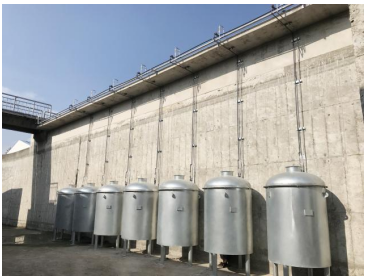Root deodorization
Root deodorization equipment
Process principle: GELOR®-ZHBR root deodorization equipment adopts GELOR®-ZHBR bioreactor and dominant biological deodorization bacteria acclimation culture mechanism. Following the principle of soil microbial deodorization, nutrients and compressed air are simultaneously added into the GELOR®-ZHBR bioreactor. Through turbulent agitation, the sludge forms a fluidized state with nutrients and compressed air, allowing for thorough mixing and contact to facilitate reaction. This process selects Bacillus as the main dominant deodorizing bacteria for cultivation and multiplication. The dominant bacteria are continuously released to the front end of the sewage treatment plant and into each sewage structure treatment unit through the sludge recirculation pump and pipeline system. These bacteria can adsorb and degrade odor-producing pollutants such as hydrogen sulfide, mercaptan, sulfide, ammonia, organic pollutants, nitrogen, and phosphorus in the process of sewage treatment. Thus, in the whole process of treatment, the odor is purified and the generation and dispersion of odor is fundamentally prevented.
Technical features:
1. Root deodorization: GELOR®-ZHBR bioreactor can induce, culture and activate soil microorganisms, reduce harmful bacteria such as coliform through antibacterial action, and have high removal rate of ammonia, nitrogen and phosphorus in water, which is accompanied by reducing deodorization during sewage treatment.
2. Operation safety: there are no special microorganisms in the filler, which will not affect the operation of the sewage treatment process.
3. Controllable culture intensity: the amount of refluxed culture sludge and the supply of biological nutrients can be adjusted based on the concentration of organic matter in the sewage; timely adjustments can be made to the cultivation intensity of deodorizing microorganisms to minimize operational costs without compromising the deodorization efficacy.
4. High economic benefits: local materials can be used to reduce investment costs. The residual sludge is rich in soil bacteria and can be recycled as high-quality fertilizer. No special collection facilities are needed and it can be easily integrated into the sewage treatment process. It also has low operating costs and ensures complete deodorization.




